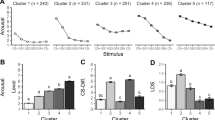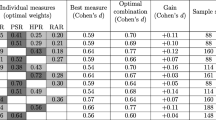Abstract
The present study evaluated the ability of 5 different fear classification procedures to discriminate between 3 fear levels and to correlate with 6 commonly used dependent measures of fear. A standardized fear assessment procedure was administered on 2 separate trials to 71 women participants. Following the completion of the assessment trials, the participants’ data were scored and regrouped according to 5 fear classification procedures (behavioral, self-report, skin conductance level, skin response amplitude, and heart rate). This design permitted each procedure to be evaluated to the same target stimulus and at the same point in time. The classifications of participants on the basis of behavior and skin conductance response were found to be most effective selection procedures with self-report, skin conductance level, and heart rate being the least. Reliability of the findings was assessed by a test–retest procedure.
Similar content being viewed by others
References
Ayres, J. J. B. (1998). Fear conditioning and avoidance. In W. O’Donohue (Ed.), Learning and Behavior Therapy (pp. 122–145). Boston: Allyn and Bacon.
Bernstein, D. A., & Allen, C. J. (1969). Fear survey (II): Normative data and factor analysis based on a large college sample. Behavior Research and Therapy, 7, 399–402.
Cacioppo, J. T., & Petty, R. D. (Eds.). (1982). Perspectives in cardiovascular psychophysiology (pp. 1–392). New York: Guilford.
Campbell, D. T., & Fiske, D. W. (1959). Convergent and discriminant validation by the multi-trait multi-method matrix. Psychological Bulletin, 56, 81–105.
Ciminero, K. S. (1986). Behavioral assessment: An overview. In A. R. Ciminero, K. S. Calhoun, (H. E. Adams (Eds.), Handbook of behavioral assessment (pp. 3–11). New York: Wiley.
Cone, J. (1979). Confounded comparisons in triple respond mode assessment research. Behaviour Assessment, 1, 85–95.
Craske, M. E., Sanderson, W. D., & Barlow, D. H. (1989). How do synchronous response systems relate to the treatment of agoraphobia: A follow-up evaluation. Behavior Research and Therapy, 25, 117–122.
Evans, I. (1986). Response structure and triple-response-model concept. In R. O. Nelson & S. C. Hayes (Eds.), Conceptual foundations of behavioral assessment (pp. 131–151). New York: Guilford.
Foa, E. B., & Kozak, M. J. (1986). Emotional processing of fear: Exposure to corrective information. Psychological Bulletin, 99, 20-35.
Fowles, D. C. (1982). Heart rates an index of anxiety: Failure of a hypothesis. In J. T. Cacioppo & R. D. Petty (Eds.), Perspectives in cardiovascular psychophysiology (pp. 93–126). New York: Guilford.
Hodgson, R., & Rachman, S. (1974). Desynchrony in measures of fear. Behavior, Research and Therapy, 12, 319–326.
Kaloupek, D. G., & Levis, D. J. (1980). The relationship between stimulus specificity and self-report indices in assessing fear of heterosexual social interaction: A test of the unitary response hypothesis. Behavioral Assessment, 2, 267–281.
Kaloupek, D. G., & Levis, D. J. (1983). Issues in the assessment of fear: Response concordance and the prediction of avoidance behavior. Journal of Behavioral Assessment, 5, 239–260.
Kozak, M. I., & Miller, G. A. (1982). Hypothetical constructs vs. intervening variables: A reappraisal of the three system model of anxiety assessment. Behavioral assessment, 4, 347–358.
Lang, P. J. (1968). Fear reduction and fear behavior: Problem in treating a construct. In J. M. Shlier (Ed.), Research in psychotherapy (Vol. 3, pp. 90–102). Washington, DC: American Psychological Association.
Lang, P. J. (1985). The cognitive psychophysiology of emotion: Fear and anxiety. In A. H. Tuma & J. O. Maser (Eds.), Anxiety and the anxiety disorders (pp. 131–170). Hillsdale, NJ: Erlbaum.
Levis, D. J. (1969). The phobic test apparatus: An objective measure of human avoidance behavior to small animals. Behaviour Research and Therapy, 7, 309–315.
Levis, D. J. (1989). The case for a return to a two-factor theory of avoidance: The failure of non-fear interpretations. In S. B. Klein & R. R. Mowrer (Eds.), Contemporary learning theories, Pavlovian conditioning and the status of traditional learning theory (pp. 227–277). Hillsdale, NJ: Erlbaum.
Levis, D. J., & Brewer, K. E. (2001). The neurotic paradox: Attempts by two-factor theory and alternative avoidance models to resolve the issues associated with sustained avoidance responding in extinction. In R. R. Mowrer & S. B. Klein (Eds.), Handbook of contemporary learning theories (pp. 561–597). Hillsdale, NJ: Erlbaum.
Levis, D. J., & Smith, J. E. (1987). Getting individual differences in autonomic reactivity to work for instead of against you: Determining the dominant “psychological” stress channel on the basis of a “biological” stress test. Psychophysiology, 24, 346–352.
Lykken, D. T., Rose, R., Luther, B., & Maley, M. (1966). Correcting psychophysiological measures for individual differences in range. Psychological Bulletin, 66, 481–484.
Lykken, D. T., & Venables, P. (1971). Direct measurement of skin conductance: A proposal for standardization. Psychophysiology, 8, 656–672.
McAllister, D. E., & McAllister, W. R. (1991). Fear theory and aversively motivated behavior: Some controversial issues. In S. D. Klein & R. R. Mowrer (Eds.), Contemporary learning theories, Pavlovian conditioning and the status of traditional learning theory (pp. 135–163). Hillsdale, NJ: Erlbaum.
Mowrer, O. H. (1939). A stimulus-response analysis and its role as a reinforcing agent. Psychological Review, 46, 553–565.
Mowrer, O. H. (1947). On the dual nature of learning—A reinterpretation of “conditioning” and “problem-solving.” Harvard Educational Review, 17, 102–148.
Mowrer, O. H. (1960). Learning theory and behavior. New York: Wiley.
Nay, W. R. (1979). Multimethod clinical assessment. New York: Gardner.
Nelson, R. O., & Hayes, S. C. (1981). Nature of behavioral assessment. In M. Hersen & A. S. Bullock (Eds.), Behavioral assessment: A practical handbook (2nd ed., pp. 3–27). New York: Pergamon.
Obrist, P. A. (1983). Cardiac–behavioral interaction: A critical appraisal. In J. T. Cacioppo & R. E. Petty (Eds.), Perspective in cardiovascular psychophysiology. New York: Guilford.
Ohman, A. (1987). Psychophysiology of emotion: An evolutionary–cognitive perspective. In P. K. Ackles, J. R. Jennings, & M. E. H. Coles (Eds.), Advances in psychophysiology: Vol. 2 (pp. 79–127). Greenwich, CT: JAI Press.
Peterson, D. A., & Levis, D. J. (1985). The assessment of bodily injury fears via the behavioral avoidance slide-test. Behavioral Assessment, 7, 173–184.
Rachman, S., & Hodgson, R. I. (1974). Synchrony and desynchrony in fear and avoidance. Behavior Research and Therapy, 12, 311–318.
Sartory, G., Rachman, S., & Grey, S. (1977). An investigation of the relationship between reported fear and heart rate. Behaviour Research and Therapy, 15, 435–438.
Smith, J. E., & Levis, D. J. (1991). Maximizing individual autonomic reactivity: A general operating procedure for pre-selecting the most responsive autonomic channel. Journal of Psychophysiology, 5, 281–288.
Stampfl, T. G. (1991). Analysis of aversive events in human psychopathology: Fear and Avoidance. In M. R. Denny (Ed.), Fear, avoidance, and phobias: A fundamental analysis (pp. 363–393). Hillsdale, NJ: Erlbaum.
Turpin, G. (1991). The psychophysiological assessment of anxiety disorders: Three-systems measurement and beyond. Psychological Assessment, 3, 366–375.
Walk, R. D. (1956). Self-ratings of fear in a fear-invoking situation. Journal of Abnormal and Social Psychology, 52, 171–178.
Zuckerman, M. (1960). The development of an affect adjective checklist for the measurement of anxiety. Journal of Consulting Psychology, 24, 457–462.
Author information
Authors and Affiliations
Corresponding author
Rights and permissions
About this article
Cite this article
Edgerly, E.S., Levis, D.J. Evaluation of Five Procedures for Classification of Participants’ Fear Levels. J Psychopathol Behav Assess 27, 201–209 (2005). https://doi.org/10.1007/s10862-005-0636-4
Accepted:
Issue Date:
DOI: https://doi.org/10.1007/s10862-005-0636-4




